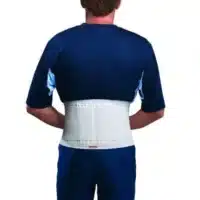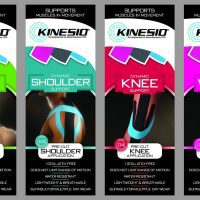-

In Stock
$49.96The Mueller Sports Medicine Adjustable Back Brace offers you custom fitting, courtesy of its tapered cut. The Adjustable Back Brace features eight steel springs with the flexibility that allows them to conform for superior lumbar support. Additional support comes from its main 9 inch elastic band. You can also adjust the tension using its 4″…
-

Free Shipping To GTA
In Stock
$87.16The Mueller Sports Medicine Back Brace, White is a comfortable and lightweight solution to back sprains and strains, an arthritic back, moderate disc conditions, muscle spasms, sciatica, chronic unstable lumbar spine or for strains of sacroiliac area. Equipped with a 9 inch wide elastic band, a large foam pad and supportive steel springs. The pad conforms to your lower back area and supports your back in the most critical areas. There is also a second 6 inch wide outer elastic band to secure the pad and provide additional back support.
SIZING: (Measure around waist) SM 28 – 32″ (71 – 81 cm) MD 32 – 36″ (81 – 91 cm) LG 36 – 40″ (91 – 102 cm) XL 40 – 44″ (102 – 111 cm) XXL 44 – 48″ (111 – 122 cm)
-

Free Shipping To GTA
In Stock
$110.04The It’s You Babe Best Cradle maternity support is ideal for the mom having twins, triplets or quads and for the mom needing support early in pregnancy. Also an effective support for non-pregnant patients who have a pendulous abdomen. Open abdominal design is cool and comfortable.
-

In Stock
$16.89 – $25.68The Mueller Sports Medicine EASYfit® Kinesiology Tape applications are designed to be simple to use and can help relieve certain overuse injuries. Three (3) applications in each package for the knee, shoulder, foot/arch, calf/ankle/neck and waist/back applications. Six (6) applications in each package for the X & Y pattern applications.
-

Free Shipping To GTA
In Stock
$79.58The Mueller Sports Medicine Kinesiology Tape – 30m Continuous Roll features Mueller’s revolutionary wave adhesive pattern for effective rehabilitation of sore, weak or damaged muscles or joints.
-

$12.42Mueller Sports Medicine Kinesiology Tape – 5m Continuous Roll is a great choice for rapid rehabilitation for your sore, weak or injured muscles and joints. With its revolutionary wave pattern adhesive, it will lift your skin as you move to optimize your circulation and promote early recovery to full health. You cn wear it for up to 5 days at a time. Made from pure high grade cotton. Latex free, highly elastic and breathable in order to perform its “lifting” function more effectively.
-

In Stock
$16.89The Mueller Sports Medicine Kinesiology Tape – I-Strip Roll will help you to treat ligament and other soft tissue injuries as well as repetitive stress injuries such as carpal tunnel.
-

In Stock
$55.03The It’s You Babe Mini Cradle is a premium maternity belt to complement every expectant mom’s collection of maternity wear. It perfectly complements maternity fashions and discretely fits under most maternity clothes. The Mini Cradle is wearable throughout pregnancy and helps provide continuous pain relief.
-

In Stock
$6.64Use Kinesio Pre-Cut Application tapes for treatment of various repetitive stress injuries. As the pieces are pre-cut, you do not need to cut them before putting them on, which simplifies application.
-

In Stock
$11.60 – $17.01Kinesio Tex Classic successfully treats a variety of orthopaedic, neuromuscular, neurological and medical conditions. It provides fast and effective pain relief and support for muscle aches and pains and directly targets the fascia (skin layers) and muscle tissue to treat the cause of muscle inflammation and pain.










